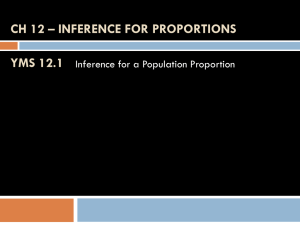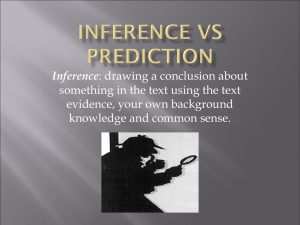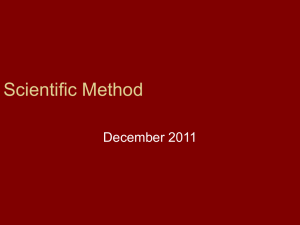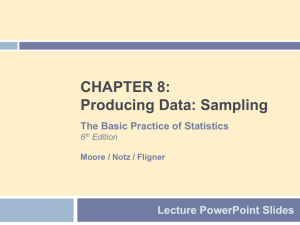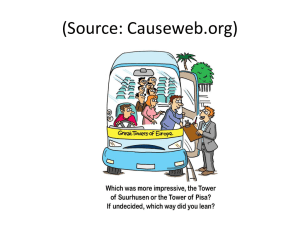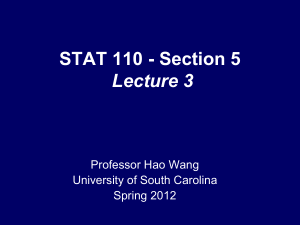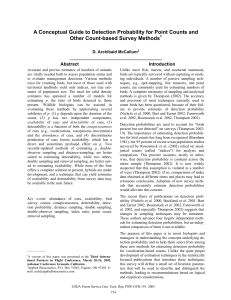Assessment and monitoring
advertisement
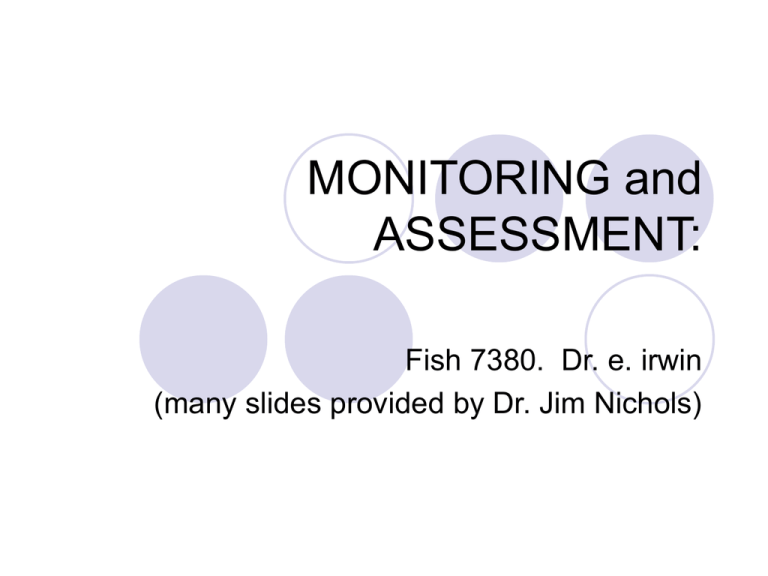
MONITORING and ASSESSMENT: Fish 7380. Dr. e. irwin (many slides provided by Dr. Jim Nichols) Rivers are inherently difficult to assess Diverse fauna (hard to enumerate) Populations change through time Abundance estimates (measures?) Habitat specialists (or not) Unidirectional flow Pseudoreplication Upstream affects downstream Standardization Efficiency Detectability Why Monitor? Science Understand ecological systems Learn stuff Management/Conservation Apply decision-theoretic approaches Make smart decisions Key Component of Science: Confront Predictions with Data Deduce predictions from hypotheses Observe system dynamics via monitoring Confrontation: Predictions vs. Observations Ask whether observations correspond to predictions (single-hypothesis) Use correspondence between observations and predictions to help discriminate among hypotheses (multiple-hypothesis) Use of Monitoring in Science Strength of inference: Manipulative experiment > Impact study > Observational study Strength of inference for observational studies: Prospective (a priori hypotheses) > Retrospective (a posteriori stories) Claim: monitoring is most useful to science when coupled with manipulations of system “Monitoring of populations is politically attractive but ecologically banal unless it is coupled with experimental work to understand the mechanisms behind system changes.” (Krebs 1991) Management/Conservation Key Elements Objective(s): what do you want to achieve Management alternatives: stuff you can do Model(s) of system response to management actions (for prediction) Measures of model credibility Monitoring program to estimate system state and other relevant variables Role of Monitoring in Management Determine system state for statedependent decisions Determine system state to assess degree to which management objectives are achieved Determine system state for comparison with model-based predictions to learn about system dynamics (i.e., do science) How to Monitor? Basic Sampling Issues Detectability Counts represent some unknown fraction of animals in sampled area Proper inference requires information on detection probability Geographic variation Frequently counts/observations cannot be conducted over entire area of interest Proper inference requires a spatial sampling design that permits inference about entire area, based on a sample Detectability: Monitoring Based on Some Sort of Count Ungulates seen while walking a line transect Tigers detected with camera-traps Birds heard at point count Small mammals captured on trapping grid Bobwhite quail harvested during hunting season Kangaroos observed while flying aerial transect Detectability: Conceptual Basis N = abundance C = count statistic p = detection probability; P(member of N appears in C) E (C ) pN Detectability: Inference Inferences about N require inferences about p C ˆ N pˆ Indices Assume Equal Detectability Ni = abundance for time/place i pi = detection probability for i Ci = count statistic for i ˆij C j / Ci ij N j / N j E (ˆij ) E ( Cj Ci ) pjN j pi N i How Do We Generate System Dynamics? Study Designs Use design that imposes, or takes advantage of, a manipulation of some sort Manipulative experimentation (randomization, replication, controls) Impact study (lacks randomization and perhaps replication, but includes time-space controls) No manipulation - observational study Prospective (confrontation with predictions from a priori hypotheses) Retrospective (a posteriori story-telling) Spatial Sampling Designs Simple random sampling Stratified random sampling Systematic sampling Cluster sampling Double sampling Adaptive sampling Dual-frame sampling Measurement Error Recognize Account for it Scale of study Match to critter Detectability Efficiency P of capture Patchy organisms (and/or habitat) Nested designs Quantify spatial patchiness Identify scale Spatial and Temporal Variation BACI design Before-After/Control-Impact Disturbances Biological response to disturbances Anthropomorphic Pulse Press Catastrophes Time scale of recovery Rapid Techniques Categorical and regression trees Other Multimetric techniques How much to sample Logistics Time $$$$ What State Variable to Monitor: 3 Levels of Inference Community – multiple species State variable: Species richness Vital rates: rates of extinction and colonization Patch – single species State variable: Proportion patches occupied Vital rates: P(patch extinction/colonization) Population – single species State variable: abundance Vital rates: P(survival, reproduction, movement) What State Variable to Monitor? Choice Depends On: Monitoring objectives Science: what hypotheses are to be addressed? Management/conservation: what are the objectives? Geographic and temporal scale Effort available for monitoring Required effort: species richness, patch occupancy < abundance Indices: Dealing with Variation in Detectability Standardization (variation sources that we can identify and control) Covariates (variation sources that we can identify and measure) Prayer (variation sources that we cannot identify, control or measure) CONCLUSION: ESTIMATE DETECTABILITY! Patch Occupancy Estimation and Modeling: Applications Amphibian monitoring Wetlands: anurans, aquatic salamanders Terrestrial plots: salamanders Spotted owl monitoring and patch-dynamic modeling Waterbird colony dynamics Tiger distribution surveys Landbird monitoring Fish monitoring Animal Abundance: Estimation and Modeling Traditional monitoring foci: Variation over time: trend Variation over space or species: relative abundance Many estimation methods (e.g., Seber 1982, Williams et al. 2002) Each estimation method is simply a way to estimate detection probability for the specific count statistic of interest Final step is always: C ˆ N pˆ Observation-based Count Statistics: Detectability Distance sampling Double sampling Marked subsets Multiple observers (dependent, independent) Sighting probability modeling Temporal removal modeling Capture-based Count Statistics: Detectability Closed-population capture-recapture models Open-population capture-recapture models Removal models (constant and variable effort) Trapping webs with distance sampling Change-in-ratio models Rate Parameters Relevant to Changes in Abundance Population growth rate Survival rate, harvest rate Reproductive rate (young per breeding adult) Breeding probability Movement rate Process variance Slope parameters for functional relationships Recommendations: Why Monitor? Monitoring is most useful when integrated into efforts to do science or management Role of monitoring in science Comparison of data with model predictions is used to discriminate among competing models Role of monitoring in management - determine system state for: State-specific decisions Assessing success of management relative to objectives Discrimination among competing models Recommendations: What to Monitor? Decision should be based on objectives Decision should consider required scale and effort Reasonable state variables Species richness Patch occupancy Abundance Recommendations: How to Monitor? Detectability Counts represent some unknown fraction of animals in sampled area Proper inference requires information on detection probability Geographic variation Frequently counts/observations cannot be conducted over entire area of interest Proper inference requires a spatial sampling design that permits inference about entire area, based on a sample Adaptive Management Seeks to optimize management decisions in the face of uncertainty, using learning at one stage to influence decisions at subsequent stages, while considering the anticipated learning in the optimization. Final considerations Other disciplines are kicking our butts Standardization can be harmful at times Remember scale… New (?) techniques for analysis are emerging Bayesian methods Heirarchical method (account for spatial dependancy)
